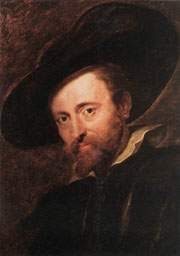The directory «Artists»
Rubens Peter Paul
(1577—1640)

Foremost Flemish painter of the 17th cent., b. Siegen, Westphalia, where his family had gone into exile because of his father’s Calvinist beliefs.
After his father’s death in 1587, the family returned to Antwerp. There the young Rubens attended a Jesuit school, served as court page, and became an accomplished linguist. After 1591 he was apprenticed to several minor painters. In 1600 he went to Italy, where he spent eight years painting in the service of the duke of Mantua, who sent him on a mission to Spain in 1603. While there he painted the magnificent equestrian portrait of the Duke of Lerma (Prado). In Italy he painted and traveled, learning by making copies from the masters. The altar paintings for the Santa Maria Nuova, Rome, are among his finest works of this period.
In 1608, after the death of his mother, Rubens returned to Antwerp, where within five years he became known as the greatest painter of his country. Much sought after as a teacher, Rubens set up an elaborate studio. He married Isabella Brant and prospered; he was deluged with commissions, especially for church decorations and altarpieces of large dimensions. To complete them Rubens organized an enormous workshop of skilled apprentices and associates, among whom were Van Dyck and Jordaens. Raising of the Cross and Descent from the Cross (1610 and 1611; cathedral, Antwerp) date from this time and are works with which Rubens already rivaled the grandiose creations of Italian art that had dominated the imagination of Northern artists for almost a century.
From 1622 to 1625 the artist executed numerous commissions for the French court, including an imposing series of large allegorical paintings of the life of Marie de’ Medici for the Luxembourg Palace that are now in the Louvre. Although his assistants did much of the work on them, it was Rubens who designed them and added the finishing touches. In this way his workshop produced numerous monumental works (e.g., The Assumption, cathedral, Antwerp).
In 1626, after the death of his wife, he entered the diplomatic service, for which his pleasing personality, knowledge of languages, and acquaintance with royalty fitted him well. In 1628 he went to Spain on a mission for England, and during his nine months in Madrid he became acquainted with Velázquez and painted the royal family. Thereafter in London, he was idolized and knighted for his peacemaking efforts. While in England he painted the Allegory of War and Peace (National Gall., London).
On his return to Antwerp in 1630 Rubens, then 53, married the 16-year-old Helen Fourment. Her portraits (Vienna Mus. and Louvre), and those of himself with her (Alte Pinakothek, Munich), are among his most joyous and personal paintings. During the last 10 years of his life Rubens worked with incredible energy, producing many of his finest pictures. Among these were the paintings for the ceiling at Whitehall for Charles I, finished in 1635.
During this time Rubens painted more than 100 works for the Spanish court alone. The Judgment of Paris and Three Graces (Prado) and Venus and Adonis (Metropolitan Mus.) belong to this period. Many of the artist’s last years were spent on his princely estate, Castle Steen, near Brussels. At the age of 63, at the height of his powers and popularity, Rubens died of gout, which had crippled him periodically for three years.
Under Rubens’s direction or influence a whole school of first-rate artists flourished in Antwerp. The volume of his work is enormous, and though he did little but supervise much of the work attributed to him, his domination was so absolute that almost everything proceeding from his workshop shows the mark of his style. He explored all fields of painting. In landscape, portrait, genre, and animal painting he was as supremely successful as in his large religious and allegorical works; smaller pictures include Helen Fourment and Her Children (Louvre) and Peasant Dance (Prado). Contemporaries doubted the durability of his delicate glazes, but his pictures are singularly well preserved. More than 2,000 paintings have been attributed to Rubens’s studio.
Ghana, 1990, Paracelsus (Rubens)
Sao Tome e Principe, 2008, Paracelsus